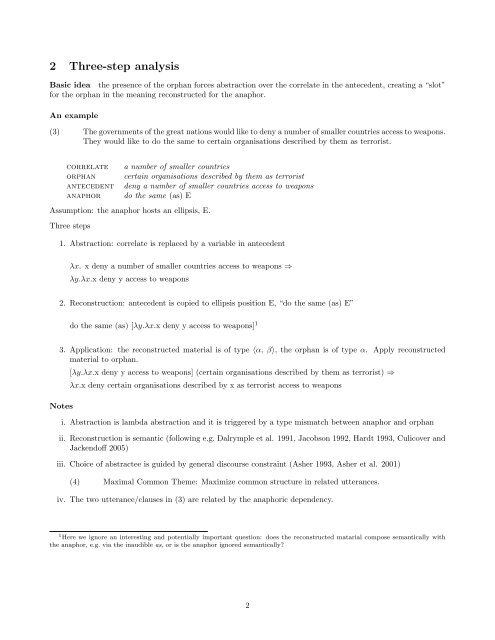handout - Linguistics
handout - Linguistics
handout - Linguistics
Create successful ePaper yourself
Turn your PDF publications into a flip-book with our unique Google optimized e-Paper software.
2 Three-step analysis<br />
Basic idea the presence of the orphan forces abstraction over the correlate in the antecedent, creating a “slot”<br />
for the orphan in the meaning reconstructed for the anaphor.<br />
An example<br />
(3) The governments of the great nations would like to deny a number of smaller countries access to weapons.<br />
They would like to do the same to certain organisations described by them as terrorist.<br />
correlate a number of smaller countries<br />
orphan certain organisations described by them as terrorist<br />
antecedent deny a number of smaller countries access to weapons<br />
anaphor do the same (as) E<br />
Assumption: the anaphor hosts an ellipsis, E.<br />
Three steps<br />
1. Abstraction: correlate is replaced by a variable in antecedent<br />
λx. x deny a number of smaller countries access to weapons ⇒<br />
λy.λx.x deny y access to weapons<br />
2. Reconstruction: antecedent is copied to ellipsis position E, “do the same (as) E”<br />
do the same (as) [λy.λx.x deny y access to weapons] 1<br />
3. Application: the reconstructed material is of type 〈α, β〉, the orphan is of type α. Apply reconstructed<br />
material to orphan.<br />
Notes<br />
[λy.λx.x deny y access to weapons] (certain organisations described by them as terrorist) ⇒<br />
λx.x deny certain organisations described by x as terrorist access to weapons<br />
i. Abstraction is lambda abstraction and it is triggered by a type mismatch between anaphor and orphan<br />
ii. Reconstruction is semantic (following e.g. Dalrymple et al. 1991, Jacobson 1992, Hardt 1993, Culicover and<br />
Jackendoff 2005)<br />
iii. Choice of abstractee is guided by general discourse constraint (Asher 1993, Asher et al. 2001)<br />
(4) Maximal Common Theme: Maximize common structure in related utterances.<br />
iv. The two utterance/clauses in (3) are related by the anaphoric dependency.<br />
1 Here we ignore an interesting and potentially important question: does the reconstructed matarial compose semantically with<br />
the anaphor, e.g. via the inaudible as, or is the anaphor ignored semantically?<br />
2

















